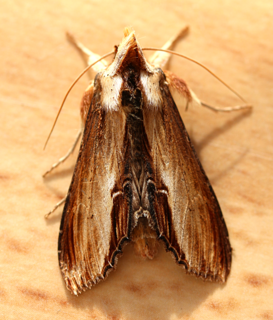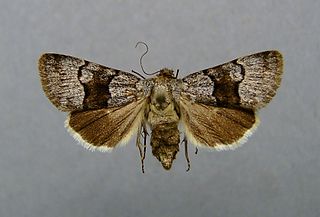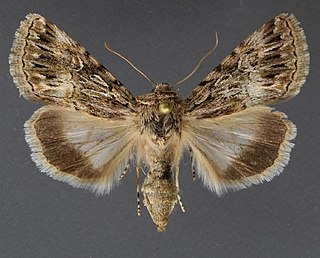
Cuculliinae is one of the larger subfamilies of moths in the family Noctuidae.

Sympistis is a genus of moths of the family Noctuidae. The genus was erected by Jacob Hübner in 1823.
Sympistis acheron is a moth of the family Noctuidae first described by James T. Troubridge in 2008. It is found from in western North America from southern British Columbia south to California at altitudes of 2,000 to 10,000 feet.
Sympistis buto is a moth of the family Noctuidae first described by James T. Troubridge in 2008. It is found in North America, including California.
Sympistis chorda is a moth of the family Noctuidae first described by Augustus Radcliffe Grote in 1880. It is found in North America from British Columbia, south to California. It was formerly known as Oncocnemis chorda, but was transferred to the genus Sympistis in 2008.
Sympistis cleopatra is a moth of the family Noctuidae first described by James T. Troubridge in 2008. It is found in Arizona. It known from only one female specimen found on the South Rim of Grand Canyon.
Sympistis collaris is a moth of the family Noctuidae first described by James T. Troubridge in 2008. It is found in the US state of Texas.
Sympistis columbia is a moth of the family Noctuidae first described by James Halliday McDunnough in 1922. It is found in Canada's British Columbia and possibly further south into the United States. It was formerly known as Oncocnemis columbia, but was transferred to the genus Sympistis in 2008.
Sympistis extremis is a moth of the family Noctuidae first described by Smith in 1890. It is found in western North America from British Columbia to Washington and Oregon. It was formerly known as Oncocnemis chorda extremis, a subspecies of Oncocnemis chorda, but was elevated to species level as Oncocnemis extremis in 1999 and transferred to the genus Sympistis in 2008.
Sympistis knudsoni is a moth of the family Noctuidae first described by James T. Troubridge in 2008. It is found in the US state of Texas.
Sympistis isis is a moth of the family Noctuidae first described by James T. Troubridge in 2008. It is found in the US state of Utah.

Sympistis incubus is a moth of the family Noctuidae first described by James T. Troubridge in 2008. It is found in the US states of Washington and Oregon at elevations of 1,800 to 4,500 feet
Sympistis horus is a moth of the family Noctuidae first described by James T. Troubridge in 2008. It is found in New Mexico.
Sympistis hathor is a moth of the family Noctuidae first described by James T. Troubridge in 2008. It is found in the US state of Oregon.

Sympistis semicollaris is a moth of the family Noctuidae first described by Smith in 1909. It is found in western North America in the vicinity of the Gulf of Georgia and east of the Cascades from south-central British Columbia to central Oregon.
Sympistis figurata is a moth of the family Noctuidae first described by Leon F. Harvey in 1875. It is found in the United States east of the Cascade Range in Washington and Oregon.

Sympistis dunbari is a moth of the family Noctuidae first described by Leon F. Harvey in 1876. It is found in wet coastal forests of North America, west of the Cascade Mountains, as far north as British Columbia, south to Utah, California and Arizona.

Sympistis sectilis is a moth of the family Noctuidae first described by Smith in 1894. It is found in North America, including Texas.

Sympistis infixa, the broad-lined sallow moth, is a moth in the family Noctuidae. It was described by Francis Walker in 1856 and is found in North America.





